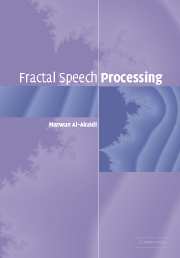Book contents
- Frontmatter
- Contents
- List of acronyms and abbreviations
- 1 Introduction to speech processing
- 2 Computational background
- 3 Statistical analysis, entropy and Bayesian estimation
- 4 Introduction to fractal geometry
- 5 Application to speech processing and synthesis
- 6 Speech processing with fractals
- 7 Speech synthesis using fractals
- 8 Cryptology and chaos
- Index
1 - Introduction to speech processing
- Frontmatter
- Contents
- List of acronyms and abbreviations
- 1 Introduction to speech processing
- 2 Computational background
- 3 Statistical analysis, entropy and Bayesian estimation
- 4 Introduction to fractal geometry
- 5 Application to speech processing and synthesis
- 6 Speech processing with fractals
- 7 Speech synthesis using fractals
- 8 Cryptology and chaos
- Index
Summary
Introduction
Speech is and will remain perhaps the most desirable medium of communication between humans. There are several ways of characterizing the communications potential of speech. One highly quantitative approach is in terms of information theory. According to information theory, speech can be represented in terms of its message content, or information. An alternative way of characterizing speech is in terms of the signal carrying the message information, that is the acoustic waveform [1].
The widespread application of speech processing technology required that touchtone telephones be readily available. The first touch-tone (dual-tone multifrequency, DTMF) telephone was demonstrated at Bell Laboratories in 1958, and deployment in the business and consumer world started in the early 1960s. Since DTMF service was introduced to the commercial and consumer world less than 40 years ago, it can be seen that voice processing has a relatively short history.
Research in speech processing by computer has traditionally been focused on a number of somewhat separable, but overlapping, problem areas. One of these is isolated word recognition, where the signal to be recognized consists of a single word or phrase, delimited by silence, to be identified as a unit without characterization of its internal structure. For this kind of problem, certain traditional pattern recognition techniques can be applied directly.
- Type
- Chapter
- Information
- Fractal Speech Processing , pp. 1 - 25Publisher: Cambridge University PressPrint publication year: 2004
- 4
- Cited by



